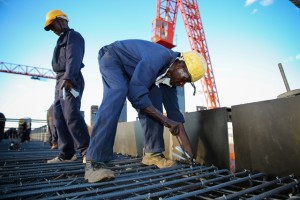Sub-Saharan Africa is 47 countries, nearly 2000 different languages and dialects, large markets and small countries. There is no single consumer model that spans the region, and in each country a huge diversity of cultural, ethnic and economic differences exist. Today 60% of the African population lives in rural environments, while by 2040 60% of the continent’s population will live in cities.
 Over the past 15 years, strong economic growth and a rapid urban transition have produced visible changes in all of Sub-Saharan Africa. In particular, not one, but of many middle classes whose needs and demands vary greatly have emerged. Broadly speaking, the middle class, defined as the section of population that earns between 2 and 20 dollars per day, is expected to grow from 355 million people to 1,1 billion by 2060. Close to 60% of this middle class, however, forms a “floating category” (earning between 2 and 4 dollars per day) and remains vulnerable.
Over the past 15 years, strong economic growth and a rapid urban transition have produced visible changes in all of Sub-Saharan Africa. In particular, not one, but of many middle classes whose needs and demands vary greatly have emerged. Broadly speaking, the middle class, defined as the section of population that earns between 2 and 20 dollars per day, is expected to grow from 355 million people to 1,1 billion by 2060. Close to 60% of this middle class, however, forms a “floating category” (earning between 2 and 4 dollars per day) and remains vulnerable.
Should Africa maintain its current growth trajectory, consumers could buy goods and services worth up to 1,4 trillion dollars in 2020.
Mobile phone penetration in Sub-Saharan Africa, however, reached 70% in the third quarter of 2013 and according to provisions, the total number of subscriptions will rise from over 560 million in 2013 to around 930 million by the end of 2019. The 67 million smartphones already in circulation (a figure that is expected to reach 360 million in 2025) are also used for payment procedures. And although Sub-Saharan Africa remains the least connected region in the world, with 16% of the population having access to the Internet, the web has registered its highest growth rate here: between 2009 and 2013, Internet penetration increased on average by 27% annually. Some zones are already super connected, as for example Kenyan urban areas, with an Internet penetration rate of 70%. Internet usage in the region is similar to Europe or Asia’s and includes social networks, correspondence by e-mail, video and music.
Continent-wide, only 5% of the population shops at large retailers or malls. This low figure is explained by the fact that the population is largely rural. Traditional distribution circuits including street traders, informal outlets and market places represent 90% of the distribution system in Sub-Saharan Africa. Brands are obliged to go into the field to meet their consumers.
 Sub-Saharan Africa’s distribution network follows a pyramid structure: large distributors feed secondary arteries that diffuse the merchandise. A variety of products flows through the capillary structure that supplies markets, street stands and reaches secluded villages. Small retailers are equipped with ambulatory kiosks and circulate by motorbike, scooter or minivans. To facilitate transportation, but also to respond to a variety of budgets, these vendors offer a variety of packaging options that includes mini formats and unitary doses for cosmetic products.
Sub-Saharan Africa’s distribution network follows a pyramid structure: large distributors feed secondary arteries that diffuse the merchandise. A variety of products flows through the capillary structure that supplies markets, street stands and reaches secluded villages. Small retailers are equipped with ambulatory kiosks and circulate by motorbike, scooter or minivans. To facilitate transportation, but also to respond to a variety of budgets, these vendors offer a variety of packaging options that includes mini formats and unitary doses for cosmetic products.
This system has disadvantages for producers whose margins are reduced by the number of intermediaries, and whose products are displayed with their competitors’ on street vendors’ stands. Some brands, such as Nice & Lovely, have established road shows to present their products to consumers in remote rural areas.
Some English speaking countries such as South Africa and Kenya now have shopping malls in adequation with international shopping standards. The specific configuration of other Sub-Saharan countries does not facilitate the development of malls, however, as infrastructure is inadequate and property taxes are high. Furthermore, products available in large retail stores are costly due to customs rates and VAT. Large retail is challenged with seducing a middle class that consists mostly of low-income households. By consequence they remain accessible primarily to the affluent.
In recent years, some of the economies that have experienced the fastest economic growth in the world are in Sub-Saharan Africa. Economic perspectives in this region are indeed promising if also contrasted. The GDP per inhabitant is on the rise. Although global growth rose to 5,3% in 2012 and to 5,6% in 2013 as a result of firm demands in export, stronger commodity markets and further public spend in infrastructure, disparities between countries are flagrant.
 In West African countries, for example, economic growth has lost steam. This slow-down is largely due to civil unrest that brought the export and finance sectors fall in the Ivory Coast, and decreased oil production in Nigeria. Growth in Ghana (12,2%), stimulated by oil production and solid growth in agriculture, mining and services sectors, however, has balanced the regional panorama. Furthermore, South Africa reached a growth rate of 3,1% in 2011 based on reduced inflation to boost consumer spend.
In West African countries, for example, economic growth has lost steam. This slow-down is largely due to civil unrest that brought the export and finance sectors fall in the Ivory Coast, and decreased oil production in Nigeria. Growth in Ghana (12,2%), stimulated by oil production and solid growth in agriculture, mining and services sectors, however, has balanced the regional panorama. Furthermore, South Africa reached a growth rate of 3,1% in 2011 based on reduced inflation to boost consumer spend.
Exports diversification has also played a key role in economic growth. Prior to 2000, Sub-Saharan Africa’s economic destiny was linked to the economies of Europe and the United-States. These markets have always been of capital importance. But closer ties with Brazil, Russia, India and China – the BRIC economies – as well as with Gulf countries and Turkey, have contributed towards both sheltering Africa from the world economic crisis and to launching its recovery. Direct foreign investment from countries such as China has contributed strongly to this result. Should this dynamic continue, Africa is expected to become an essential motor to the global economy.
Over the past 15 years, this strong economic growth has induced visible changes all over Sub-Saharan Africa and brought social change due in particular to the slow emergence of a middle class on the continent.















